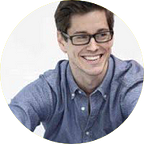Week 19, 2019
Brave New Work, Part 3: Inertia is the Problem, Trust is the Solution, and Evolution is the Method.
Each week I share three ideas for how to make work better. And this week, those ideas come in the form of closing arguments; this is the last of three installments inspired by Brave New Work — the new book by Aaron Dignan, CEO at The Ready.
Let’s dig right in.
1. Inertia is the Problem
Work is broken and it needs to be fixed. But it won’t be easy. At the core of the problem lies a fundamental misunderstanding of human nature: that people must be told what to do. The problem is pervasive too; most organizations today — Dignan calls them Legacy Organizations — are built atop this very premise. Perhaps not by choice, but the hierarchies, policies, and control mechanisms they’ve put in place are tell-tale signs: they don’t trust their people, and so they’ve built elaborate bureaucracies with which to control them. And as a result, they now find themselves unable to respond to a rapidly changing world. Distrust has made their organizations slow and lethargic. Distrust has created inertia. And in today’s environment, inertia has dire consequences.
2. Trust is the Solution
That’s the bad news. The good news is that there are organizations (a rare few) that have managed to solve this problem — usually through trial and error and usually over long periods of time. But they have managed to make meaningful change. And they’ve done so by defaulting to trust and being People Positive (w182019) which, in turn, has allowed them to become Complexity Conscious (w172019) and better able to deal with change. These select few — organizations like Morningstar, Haier, and Buurtzorg — are harbingers of things to come. They’ve paved the way (many ways, actually) for the rest of us to follow. Like William Gibson said: “The future is already here, it’s just not evenly distributed.” Dignan calls these harbingers Evolutionary Organizations.
3. Evolution is the Method
Words and important. And Dignan didn’t choose the term “Evolutionary” by accident. The name is the method and vice versa. Think of it this way: change doesn’t happen overnight. And contrary to what most consultants will tell you, you can’t transform your organization with a reorg or a new app. For change to take root, really take root, you need purposeful and sustained action — you need a program of continuous improvement that Dignan refers to as “looping”. Looping, he explains, involves three steps: sensing tensions, proposing practices, and running experiments. And this is, in fact, what the bulk of his book is about: types of tensions (e.g., “we have meetings to prepare for meetings”), types of practices (e.g., “give up preplanned agendas and start building them on the fly”), and how to address one with the other.
For more on this last part, check out the tension and practice card decks you’ll find them at theready.com/cards.
Dignan’s book is a great read. I highly recommend it. So much so, in fact, that I’ve bought copies for everyone in my management team (and now also a few of my clients). Get your copy at bravenewwork.com.
That’s all for this week.
Until next time: Make it matter.
/Andreas
